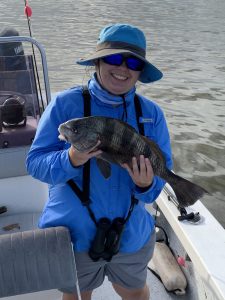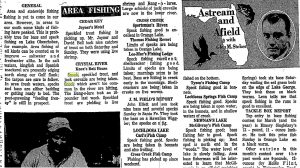Written by 2021 Summer Intern, Katie Everett
 This past summer, I had the exceptional experience of working with Charlie Martin, Mike Allen, and Ashley McDonald at the Nature Coast Biological Station in Cedar Key. My project focused on investigating the historical distribution of Common Snook (Centropomus undecimalis) in the northern Gulf of Mexico.
This past summer, I had the exceptional experience of working with Charlie Martin, Mike Allen, and Ashley McDonald at the Nature Coast Biological Station in Cedar Key. My project focused on investigating the historical distribution of Common Snook (Centropomus undecimalis) in the northern Gulf of Mexico.
When I first found out that I was being offered this internship and that this would be my project, I was both incredibly excited and admittedly, a bit lost as to where to begin. Now, I will be the first to admit that prior to this internship, I didn’t know much about fish. I do, however, love natural history and finding answers to questions. (It also helps that I love Cedar Key too, just look at this sunset!)
After meeting Charlie and talking it over, we both agreed that the best place to begin was reading up on all things snook: life history, habitat, conservation, etc. In addition, I learned the background for this whole project. Historically speaking, Common Snook are not supposed to be found as far north as Cedar Key. Freezing temperatures are lethal to snook, and so far, that seems to be what has kept them from expanding out of South Florida waters. Interestingly, mangroves are similarly limited. In the last couple of decades, hard freezes have become less and less frequent, allowing both mangroves and snook to move into the area in increasing numbers. That’s where my project comes in: mangroves have been in the area during warmer climatic periods, so is it possible that snook have been as well?
So, with this knowledge under my belt, I met with Charlie, Mike, and Ashley, and together we came up with a plan for finding out if snook had ever been here before. The first step had me searching every natural history museum’s ichthyology collection database I could access online, looking for any snook that seemed out of place. This was followed by an entirely different kind of database search: newspapers. I spent hours upon hours scouring the Gainesville Sun and Ocala Star-Banner databases, looking for any mention of snook and where they might’ve been found. While working on all of that, I was also sending emails to and interviewing anyone who might know anything about snook having been in the area, from journalists to archaeologists to charter fishing boat captains.

In the end, I came out with 341 useable records, from Tarpon Springs to the Florida Panhandle, all from the 1940s to now. Interestingly, more than 60% of those records are from the last ten years, and 85% are from the last 30 years! That would indicate to us that perhaps this range expansion is perhaps a novel occurrence, and in need of further research.
Once again, a huge thank you to everyone at Nature Coast Biological Station and everyone else who helped out with this project; I couldn’t have done it without you. It’s been a blast!
 2
2
